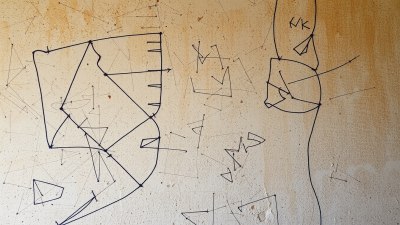Stories Scratched Into the Walls
Explore the haunting narratives behind the marks left on walls through time.

Image created with Flux Schnell
Every scratch on a wall tells a story, a fragment of history etched into the fabric of our built environment. These markings are often overlooked, considered mere blemishes on an otherwise pristine surface. However, upon closer examination, they offer insight into human experiences, emotions, and the stories we carry through life. From ancient inscriptions in caves to modern graffiti in urban settings, these marks serve as a canvas for expression, reflection, and sometimes, desperation.
Walls have been witnesses to countless moments in history. Throughout the ages, individuals have carved their thoughts, feelings, and experiences into the surfaces around them. It raises the question: what compels individuals to scratch or etch their stories into the walls? The motivations behind these actions can vary significantly, ranging from the desire for recognition, a cry for help, to sheer artistic expression.
The Ancient Origins
Human beings have been leaving marks on walls since the dawn of civilization. The earliest examples can be found in prehistoric caves, where our ancestors used rudimentary tools to etch symbols and figures into stone. These cave paintings and carvings, often depicting animals or human figures, served not only as an artistic expression but also as a means of communication and storytelling across generations.
As civilizations progressed, so did the practices surrounding wall inscriptions. The ancient Egyptians inscribed hieroglyphs into their temples, recounting tales of gods, pharaohs, and significant events. Similarly, the Romans adorned their structures with detailed frescoes and carvings, merging art and storytelling seamlessly. These practices served both decorative functions and practical purposes, preserving narratives that would endure long after their creators were gone.
Middle Ages to Renaissance
In the Middle Ages, churches and cathedrals became the primary sites for wall inscriptions. Pilgrims and worshippers would leave their marks, often as a form of devotion. Graffiti emerged as a form of protest or social commentary during this time, with individuals etching political messages and critiques into church walls. This act of rebellion allowed the voiceless to speak their truths against oppressive regimes.
The Renaissance era witnessed a flourish of artistic talent, and walls became canvases for creativity. Artists such as Michelangelo and Raphael used walls to showcase their prowess, transforming sacred spaces into breathtaking works of art. Here, stories were told through imagery, capturing not just the moment but the emotions and struggles of the human experience. However, the average person also contributed to this narrative by leaving smaller marks and writing their names or messages.
The Industrial Revolution and Urban Graffiti
The Industrial Revolution brought dramatic changes to urban environments, leading to crowded cities where walls were bombarded with different forms of expression. As industrialization progressed, so did the opportunity for anonymity. With this anonymity came a surge in graffiti, as the marginalized and disenfranchised sought to make their voices heard. Streets, subways, and public spaces became canvases for tagging and storytelling.
Graffiti, often viewed as vandalism, tells powerful stories of resistance, identity, and belonging. Artists were able to convey messages relevant to their communities, encapsulating social issues, struggles, and triumphs within their work. Iconic pieces, like the works of Banksy, often combine political statements with vivid imagery, giving voice to the voiceless and sparking dialogue about pressing social matters.
Social Media and Modern Influences
As we moved further into the 21st century, the advent of social media redefined how people tell their stories. While physical walls still serve as important outlets, digital platforms have merged with traditional methods of storytelling. Artists and individuals alike share images of wall art and graffiti online, making their stories accessible to a global audience.
This digital age has also led to a resurgence in interest in public art and murals. Cities are increasingly recognizing the value of street art as a legitimate form of expression and a means of beautifying urban landscapes. Community-driven mural projects invite artists to collaborate, telling stories unique to each neighborhood while transforming blank walls into vibrant narratives.
The Emotional Impact of Wall Scratches
Beyond the physical act of scratching into walls lies a deep emotional connection. When individuals mark a wall, they may be weaving their own story into a communal tapestry of human experience. This act can serve various purposes, such as healing, remembrance, or a plea for connection. Markings of a lost loved one or a significant event can linger on walls, memorializing moments that may fade from memory.
For many, leaving a mark can be an act of catharsis, releasing pent-up emotions and solidifying one's place in the world. Additionally, these inscriptions often connect us through shared experiences, emotions, and histories, creating an intricate web of stories that transcend time and geographical boundaries.
The Cultural Significance of Wall Stories
The markings on walls are a form of cultural expression, reflecting the values, beliefs, and aspirations of the people who created them. They provide a tangible link to history, capturing the essence of a community’s journey over time. Whether through art or simple inscriptions, these stories contribute to a collective identity, uniting diverse voices under a shared narrative.
Furthermore, many cities are recognizing the importance of preserving these stories. Conserving historical markings allows us to honor our past while encouraging future generations to appreciate the art and history laid before them. This conscious effort fosters a sense of belonging and continuity as we navigate an ever-changing world.
The stories scratched into walls are much more than mere marks; they are powerful narratives of human experience, emotion, and connection. From the ancient caves of our ancestors to the modern urban landscapes filled with graffiti, these inscriptions invite us to pause and reflect on the lives that came before us and the stories waiting to be told. As we consider the significance of these markings, we acknowledge the creative spirit that drives us to leave our imprint on the world around us.











